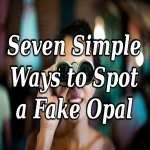 The jewelry market is filled with lab created gemstones that deliver amazing clarity and color at a much lower price than their naturally made counterparts. Lab created emeralds, diamonds and opals have made stunning gemstone jewelry more accessible. At the same time, people who want naturally created gemstones have growing concerns about how they can tell the difference between natural gemstones and ones created synthetically.
The jewelry market is filled with lab created gemstones that deliver amazing clarity and color at a much lower price than their naturally made counterparts. Lab created emeralds, diamonds and opals have made stunning gemstone jewelry more accessible. At the same time, people who want naturally created gemstones have growing concerns about how they can tell the difference between natural gemstones and ones created synthetically.
1. Body Tone
Body tone is one of the easiest ways to determine an opal's origins. Synthetic opals - and particularly doublets or triplets - are often created with a dark undertone. Naturally occurring white and crystal opals have a much lighter overall body tone, including areas which have various levels of transparency. (via Geology.com)
(via Geology.com)
2. Layers
Synthetic opals are created by mimicking the opal creation process and speeding it along a fair bit. Some opals are literally grown in a lab setting, but the process can take more than a year. The quicker - and cheaper - options is to create an opal stage and then cover it with a dome that completes the look. In many cases, this is accomplished by slicing an opal and using a sliver of that original opal as a base. Then a dome of polymer or plastic is added on top to create the tell-tale opal look. Examine your opal from the side as gemstones made in this manner have obvious layers when viewed from the side.3. Check the Back
While opals are worn with their most colorful surface facing out, checking the back of the stone is how you can determine its authenticity. Manufactured opals are typically backed with glass, black plastic or vitrolite. These manufactured stones also have regimented, regular and smooth seams since each layer is highly processed. Naturally occurring opals, on the other hand, will often feature irregular lines and seams along the back and sides.4. From the Top Down
Another fairly easy way to determine if an opal is real or not is by examining how it looks head on. The the top part of the stone seems to magnify the coloring or patterns beneath, it is likely to be real. But it shouldn't look overly glossy. A high shine and crystal clear appearance are the hallmarks of resin or plastic used to create the dome of the opal.5. Artificial Flashes
Many opals are known for their flashes of color which adds an extra dimension to their appearance. In some cases, manufacturers of fake opals will use slivers of tinsel or foil in order to recreate this look. If the colors and flashes you see upon close examination appear close together or tight, consider that a red flag.



